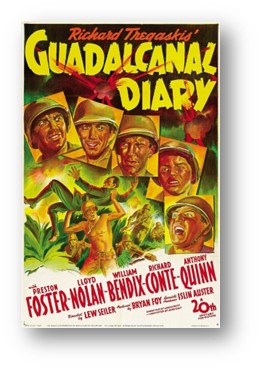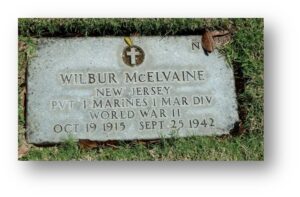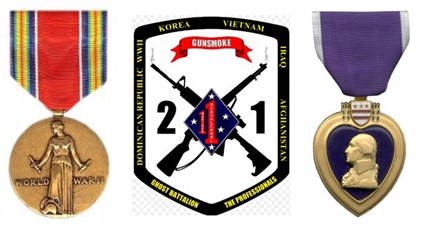Name: McElvaine, Wilbur, PVT, USMC
Local address: 42 Wilson Avenue, Matawan, NJ
Wilbur had the unhappy distinction of being the first area resident killed in WWII. The youngest of four sons of Elwood McElvaine (1878-1969) and Mary Wievie (1881-1948), he was born October 19, 1915 in Cliffwood, NJ. Father Elwood had lost his arm in a sawmill accident in 1895, and subsequently worked for the Cliffwood Brick Company in its office.
Wilbur was an accomplished student and gifted speaker. A “life sketch” of him in the Asbury Park Press on May 8, 1933 indicated he “entered the Matawan schools in the first grade”; however, a 1923 article indicated he made the honor roll at the Hazlet Grade School. He did attend Matawan High School, though, and articles in local papers praised his public speaking ability. He was elected President of his senior class, graduating in 1933. After graduation, he was employed by Hanson-Van Winkle-Dunn manufacturing company on Broad Street. While working there, he completed a correspondence course in chemistry in late 1941.
He enlisted in the Marines on January 26, 1942, the month after Pearl Harbor and was at Parris Island for boot camp by the end of the month. According to his father, he enlisted in the Marines because “he wanted to be where there was action.” He completed basic in April, and was assigned to Fall River, NC for advanced training, eventually being assigned to the 2nd Battalion, 1st Marine Regiment, 1st Marine Division. By July he was on the West Coast and was soon deployed to the Pacific.
 One of his fellow Marines, Corporal Francis J. Ziemba of Chicopee, MA, wrote Wilbur’s parents and described his final days on the island of Guadalcanal in the Solomon Islands. Guadalcanal is one of the most hallowed grounds in Marine Corps history, on an equal plane with Belleau Wood in WWI and Iwo Jima. It was the first significant US action that stopped and started pushing back the Japanese advance.
One of his fellow Marines, Corporal Francis J. Ziemba of Chicopee, MA, wrote Wilbur’s parents and described his final days on the island of Guadalcanal in the Solomon Islands. Guadalcanal is one of the most hallowed grounds in Marine Corps history, on an equal plane with Belleau Wood in WWI and Iwo Jima. It was the first significant US action that stopped and started pushing back the Japanese advance.
On August 7, 1942, Wilbur and Ziemba were in the same landing craft that hit the beach on the island. They were among the first to set foot on Henderson Field, and took part in the bloody battle of the Tenaru River two weeks later, where wave after wave of Japanese soldiers assaulted the dug in Marines. Around 800 Japanese were killed, along with 40 Americans.
On the evening of September 25th, Wilbur and Ziemba were on a patrol consisting of about 40 Marines when they were ambushed and surrounded by a superior enemy force. The patrol leader asked for a volunteer to break through  the enemy lines and get reinforcements – Wilbur was the first to step forward. In the attempt he was killed by hostile fire. The Marines were eventually rescued, and Ziemba personally buried Wilbur’s body, which was subsequently reinterned in the National Memorial Cemetery of the Pacific in Honolulu. In 1957, a formal ceremony was conducted at the cemetery when Matawan VFW Post 2218 former auxiliary president Alice Chadwick laid a wreath on Wilbur’s grave. The post is named after Wilbur and another Matawan KIA.
the enemy lines and get reinforcements – Wilbur was the first to step forward. In the attempt he was killed by hostile fire. The Marines were eventually rescued, and Ziemba personally buried Wilbur’s body, which was subsequently reinterned in the National Memorial Cemetery of the Pacific in Honolulu. In 1957, a formal ceremony was conducted at the cemetery when Matawan VFW Post 2218 former auxiliary president Alice Chadwick laid a wreath on Wilbur’s grave. The post is named after Wilbur and another Matawan KIA.
An outstanding book on the campaign, Guadalcanal Diary by war correspondent Richard Tregaskis, is a must read for anyone wishing to experience what the Marines went through in the campaign. I read it over 60 years ago and recently re-read it – it’s an outstanding work.
An interesting aside: newspaper articles reporting Wilbur’s death indicated he had an older brother Elwood, Jr (1906-1982) who had joined the navy in 1925 whom his parents hadn’t heard from since the war started – letters were returned marked “unable to locate.” I researched him and determined that he was a bosun’s mate aboard the USS Stringham (APD-6), a converted WWI destroyer used as a fast transport. That ship was used to supply Guadalcanal while his brother was fighting there. It is highly likely that due to war time censoring of information, neither was aware of the other’s presence.


NO COMMENTS